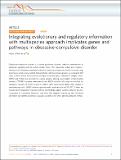| dc.contributor.author | Noh, Hyun Ji | |
| dc.contributor.author | Flannick, Jason | |
| dc.contributor.author | O’Dushlaine, Colm | |
| dc.contributor.author | Swofford, Ross | |
| dc.contributor.author | Howrigan, Daniel | |
| dc.contributor.author | Genereux, Diane P. | |
| dc.contributor.author | Johnson, Jeremy | |
| dc.contributor.author | van Grootheest, Gerard | |
| dc.contributor.author | Grünblatt, Edna | |
| dc.contributor.author | Andersson, Erik | |
| dc.contributor.author | Djurfeldt, Diana R. | |
| dc.contributor.author | Patel, Paresh D. | |
| dc.contributor.author | Koltookian, Michele | |
| dc.contributor.author | M. Hultman, Christina | |
| dc.contributor.author | Pato, Michele T. | |
| dc.contributor.author | Pato, Carlos N. | |
| dc.contributor.author | Rasmussen, Steven A. | |
| dc.contributor.author | Jenike, Michael A. | |
| dc.contributor.author | Hanna, Gregory L. | |
| dc.contributor.author | Stewart, S. Evelyn | |
| dc.contributor.author | Knowles, James A. | |
| dc.contributor.author | Ruhrmann, Stephan | |
| dc.contributor.author | Grabe, Hans-Jörgen | |
| dc.contributor.author | Wagner, Michael | |
| dc.contributor.author | Rück, Christian | |
| dc.contributor.author | Mathews, Carol A. | |
| dc.contributor.author | Walitza, Susanne | |
| dc.contributor.author | Cath, Daniëlle C. | |
| dc.contributor.author | Lindblad-Toh, Kerstin | |
| dc.contributor.author | Tang, Ruqi | |
| dc.contributor.author | Feng, Guoping | |
| dc.contributor.author | Karlsson, Elinor | |
| dc.date.accessioned | 2017-11-20T19:10:11Z | |
| dc.date.available | 2017-11-20T19:10:11Z | |
| dc.date.issued | 2017-10 | |
| dc.date.submitted | 2017-01 | |
| dc.identifier.issn | 2041-1723 | |
| dc.identifier.uri | http://hdl.handle.net/1721.1/112251 | |
| dc.description.abstract | Obsessive-compulsive disorder is a severe psychiatric disorder linked to abnormalities in glutamate signaling and the cortico-striatal circuit. We sequenced coding and regulatory elements for 608 genes potentially involved in obsessive-compulsive disorder in human, dog, and mouse. Using a new method that prioritizes likely functional variants, we compared 592 cases to 560 controls and found four strongly associated genes, validated in a larger cohort. NRXN1 and HTR2A are enriched for coding variants altering postsynaptic protein-binding domains. CTTNBP2 (synapse maintenance) and REEP3 (vesicle trafficking) are enriched for regulatory variants, of which at least six (35%) alter transcription factor-DNA binding in neuroblastoma cells. NRXN1 achieves genome-wide significance (p = 6.37 × 10⁻¹¹) when we include 33,370 population-matched controls. Our findings suggest synaptic adhesion as a key component in compulsive behaviors, and show that targeted sequencing plus functional annotation can identify potentially causative variants, even when genomic data are limited. | en_US |
| dc.description.sponsorship | National Institute of Mental Health (U.S.) (Grant 1R21MH109938-01) | en_US |
| dc.publisher | Nature Publishing Group | en_US |
| dc.relation.isversionof | http://dx.doi.org/10.1038/s41467-017-00831-x | en_US |
| dc.rights | Creative Commons Attribution 4.0 International License | en_US |
| dc.rights.uri | http://creativecommons.org/licenses/by/4.0/ | en_US |
| dc.source | Nature | en_US |
| dc.title | Integrating evolutionary and regulatory information with a multispecies approach implicates genes and pathways in obsessive-compulsive disorder | en_US |
| dc.type | Article | en_US |
| dc.identifier.citation | Noh, Hyun Ji et al. “Integrating Evolutionary and Regulatory Information with a Multispecies Approach Implicates Genes and Pathways in Obsessive-Compulsive Disorder.” Nature Communications 8, 1 (October 2017): 774 © 2017 The Author(s) | en_US |
| dc.contributor.department | Massachusetts Institute of Technology. Department of Brain and Cognitive Sciences | en_US |
| dc.contributor.mitauthor | Tang, Ruqi | |
| dc.contributor.mitauthor | Feng, Guoping | |
| dc.contributor.mitauthor | Karlsson, Elinor | |
| dc.relation.journal | Nature Communications | en_US |
| dc.eprint.version | Final published version | en_US |
| dc.type.uri | http://purl.org/eprint/type/JournalArticle | en_US |
| eprint.status | http://purl.org/eprint/status/PeerReviewed | en_US |
| dc.date.updated | 2017-11-03T17:23:50Z | |
| dspace.orderedauthors | Noh, Hyun Ji; Tang, Ruqi; Flannick, Jason; O’Dushlaine, Colm; Swofford, Ross; Howrigan, Daniel; Genereux, Diane P.; Johnson, Jeremy; van Grootheest, Gerard; Grünblatt, Edna; Andersson, Erik; Djurfeldt, Diana R.; Patel, Paresh D.; Koltookian, Michele; M. Hultman, Christina; Pato, Michele T.; Pato, Carlos N.; Rasmussen, Steven A.; Jenike, Michael A.; Hanna, Gregory L.; Stewart, S. Evelyn; Knowles, James A.; Ruhrmann, Stephan; Grabe, Hans-Jörgen; Wagner, Michael; Rück, Christian; Mathews, Carol A.; Walitza, Susanne; Cath, Daniëlle C.; Feng, Guoping; Karlsson, Elinor K.; Lindblad-Toh, Kerstin | en_US |
| dspace.embargo.terms | N | en_US |
| dc.identifier.orcid | https://orcid.org/0000-0002-8021-277X | |
| mit.license | PUBLISHER_CC | en_US |
